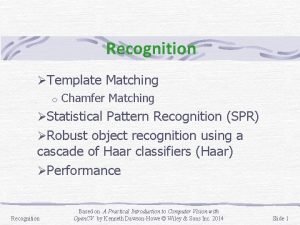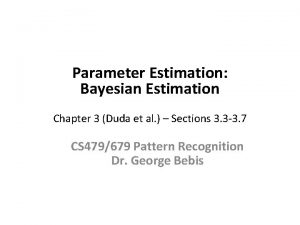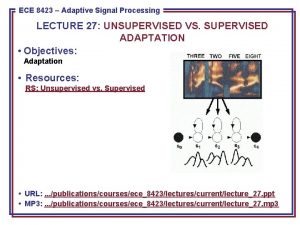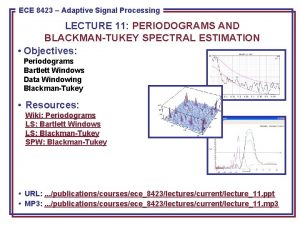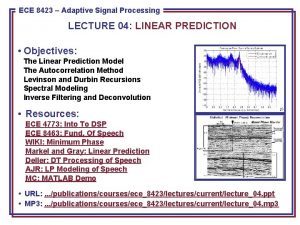ECE 8423 8443Adaptive Pattern Recognition ECE Signal Processing




- Slides: 4

ECE 8423 8443––Adaptive Pattern Recognition ECE Signal Processing LECTURE 22: MAP FOR MARKOV CHAINS • Objectives: Review MAP Derivation • Resources: JLG: MAP For Markov Chains XH: Spoken Language Processing LP: MAP For Music Recognition MB: MAP Adaptation of Grammars XH: MAP Adaptation of LMs • URL: . . . /publications/courses/ece_8423/lectures/current/lecture_22. ppt • MP 3: . . . /publications/courses/ece_8423/lectures/current/lecture_22. mp 3

Introduction • Consider the problem of estimating given a sequence of observations, o. The maximum a posteriori (MAP) estimate of is given by: • Three key issues need to be addressed: the choice of the prior distribution family, the specification of the parameters for the prior densities, and the evaluation of the MAP. • These problems are closely related since an appropriate choice of the prior distribution can greatly simplify the MAP estimation process. • For both finite mixture densities and hidden Markov models, EM must be used because the distribution lacks a sufficient statistic due to the underlying hidden process (i. e. , the state mixture component and the state sequence of a Markov chain for an HMM). • For HMM parameter estimation, EM is known as the Baum-Welch (BW) algorithm and alternates between maximizing the likelihood function of the observed data and reestimating the parameters using expectations. • We will assume the data is generated from a multivariate Gaussian distribution, and the T observations are i. i. d. and independent. • We will ignore the use of mixture densities (see Gauvain, 1994 for the details). ECE 8423: Lecture 22, Slide 1

The Likelihood Function • The likelihood of the data (with respect to the kth state) can be written as: • The matrix r is referred to as the precision matrix and is defined as the inverse of the covariance matrix. The constant terms in the Gaussian are ignored because they don’t affect the optimization. • The prior distribution for the Gaussian mean and covariance is approximated with a normal-Wishart distribution: • A Wishart distribution is a multidimensional generalization of the Chi-squared distribution. A Chi-squared distribution results from taking the sum of the squares of Gaussian random variables. • The vector and matrix, • , are the prior density parameters for : number of degrees of freedom; ECE 8423: Lecture 22, Slide 2 : proportional to the prior prob. .

MAP Estimates for a Gaussian • The EM algorithm can be applied to find the ML estimates. The auxiliary function, , that is maximized is the combination of: • The auxiliary function, , is given by: • Continue from the Gauvain paper. ECE 8423: Lecture 22, Slide 3



